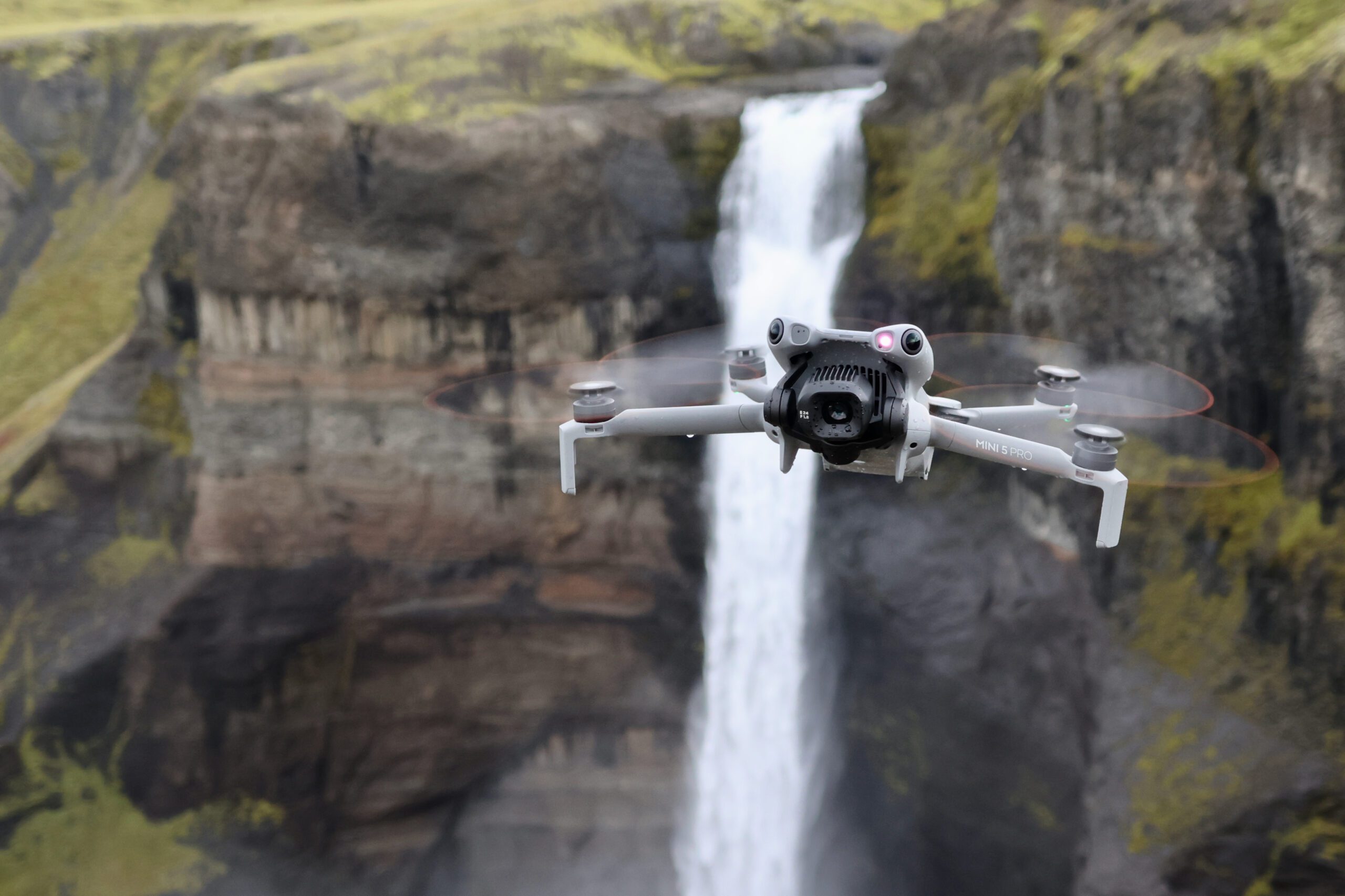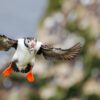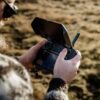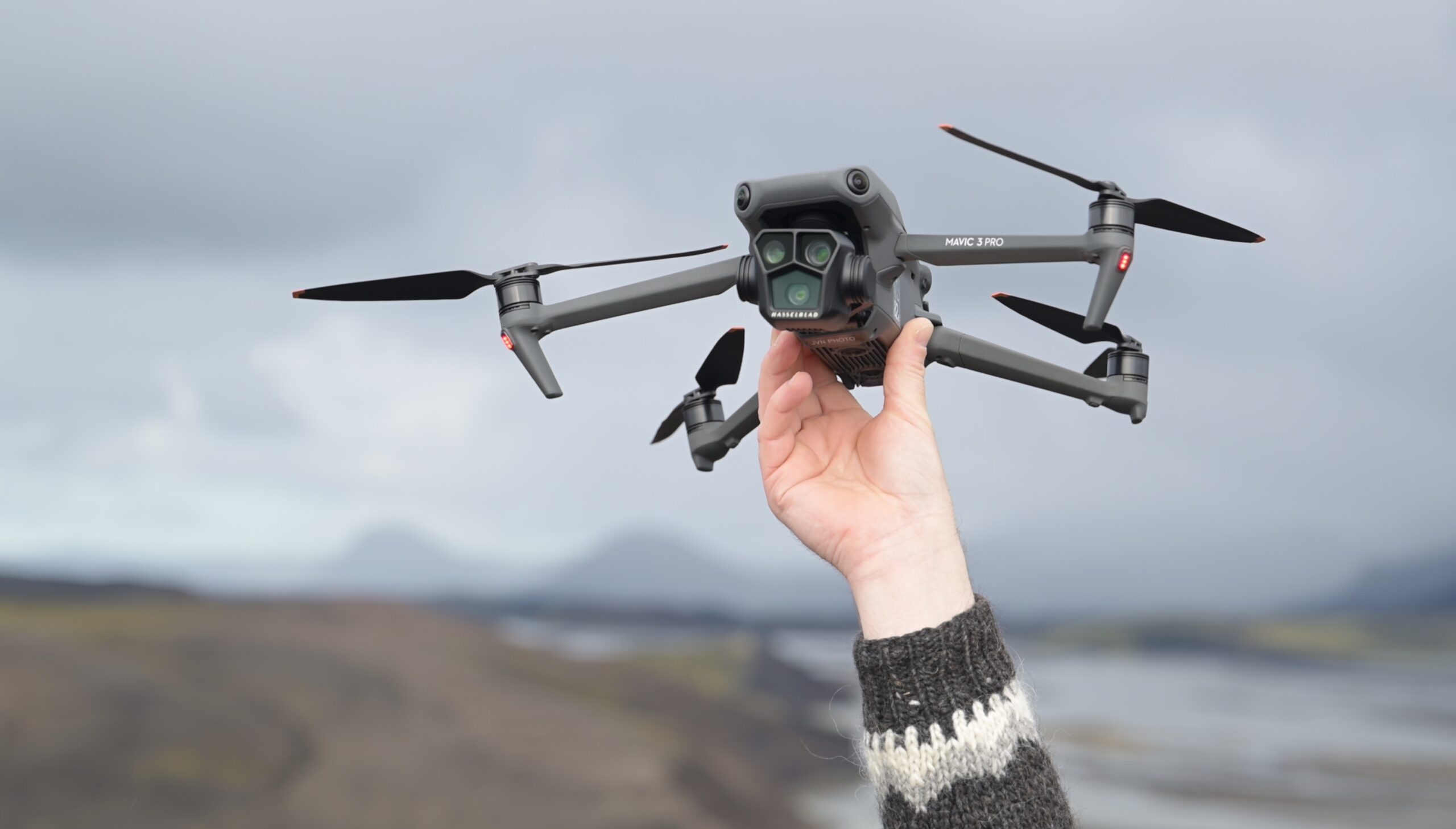Today, DJI finally released the long anticipated DJI Mini 5 Pro. The Mini 5 Pro will undoubtedly become a very popular choice amongst aspiring & experienced drone pilots given it’s a new addition to the least restrictive drone category as a sub-250 gram drone (C0 category). DJI Mini 5 Pro packs a few major improvements that make it a much more worthwhile upgrade this time around compared to its latest iteration. This was almost expected because its predecessor, the DJI Mini 4 Pro, is almost two years old by now.
I got the chance to test the DJI Mini 5 Pro several weeks before its release, allowing me to thoroughly find out what this little powerhouse has to offer. I took it out to explore some of my favourite areas while also facing some of the rougher weather Iceland has to offer. If you are interested in learning what the DJI Mini 5 Pro has to offer from a photographer’s perspective, then make sure to continue reading!
Disclaimer: While I did get access to a pre-release version of the DJI Mini 5 Pro, no money exchanged hands. DJI did not ask me to write this review, nor did they have any insight into it beforehand. However, when you make a purchase using one of the affiliate links in this article, I may earn a small commission.
You can now get 30% off the Drone Photography Masterclass. Scroll down below to enjoy the offer!
I put the DJI Mini 5 Pro to test in the Icelandic Highlands, where it wasn’t spared by wind & rain.
How DJI Mini 5 Pro Improves On Its Predecessor
DJI Mini 5 Pro brings a few big upgrades, and a whole lot of smaller quality-of-life improvements, that make this an overall great package. However, it is clear that the main selling point of the Mini 5 Pro is its compactness and weight which, fortunately, remains unchanged over its predecessors. DJI has done a great job upgrading a few key factors while still keeping the Mini 5 Pro below the crucial 250 grams in weight.
Mini 5 Pro: The Main Benefits Of A Sub-250 Gram Drone
In recent years, sub-250 gram drones have become incredibly popular. This isn’t only attributed to their cheaper price point and light weight. A potentially bigger factor is that sub-250 gram drones generally are not as restricted as bigger drones. For example in Europe, there is currently no need to get a license in order to fly a C0 (sub-250 gram) drone which seems to be a huge benefit for most people. I don’t particularly think that should be a showstopper to buy a bigger drone, given how easy the tests are, but it does seem to be an important factor for many.
Finally, a 1″ Sensor On A Mini Drone!
Possibly the biggest selling point of the DJI Mini 5 Pro, is its new 1 inch, 12,5 megapixel sensor. This is the first time a drone of this kind packs a 1 inch sensor, which provides better noise performance. Combined with that sensor comes a F1.8 aperture lens that has a 24mm full frame equivalent focal length.
The Mini 5 Pro is also capable of producing 50 megapixel images, using the quad-bayer technology which DJI is now using in all of their drones. There is also a 2x zoom option, which provides a 48mm full frame equivalent focal length. But it should be noted that this is a digital zoom only, which is not particularly useful for photography purposes. However, in video it definitely has its uses. The image quality produced by this new sensor is decent and on par with what I have seen from the Air 3S’ main camera. Thanks to the F1.8 aperture, it is also more capable in lower light situations.
I do wish DJI would finally give us a higher resolution sensor on the smaller drones. While 12,5 megapixels is definitely enough for social media use, in this day & age it is not something you would make large prints of. Perhaps with the next version of the Air 3S? That said, if you create aerial panoramas the Mini 5 Pro is certainly capable enough to do the job.
Aside from still photography, the Mini 5 Pro is also capable of recording up to 4K 60fps HDR video, as well as 4K 120fps slow motion video. In Auto mode, the Mini 5 Pro has an impressive 14 stops of dynamic range, which proves very useful when editing videos of high contrast scenes.
As always, I let the images speak for themselves so below is a small collection of single shots taken on the Mini 5 Pro. However, you are interested in seeing a comparison of RAW files taken on Mini 5 Pro and Mini 4 Pro, make sure to check out my separate RAW comparison blog.
Mini 5 Pro Borrows A Few Gimbal Tricks From Mavic 4 Pro
After the introduction of horizontal tilt on Mavic 4 Pro, I was wondering what DJI’s next move would be with other drones. And with Mini 5 Pro, we get a little glimpse at what may be coming to other models. Mini 5 Pro has a redesigned gimbal that now also allows for horizontal tilt. This means you can now rotate the camera 225 degrees horizontally. This doesn’t have much use for photography but can certainly be interesting for videography.
Just like on previous iterations, Mini 5 Pro has a true vertical mode too where the camera module can rotate 90 degrees. This means you can use the full sensor to shoot vertically as well as horizontally.
In a way, The Mini 5 Pro‘s redesigned gimbal is a much better concept than the Infinity gimbal on Mavic 4 Pro. By this I mean that my main frustration with the Mavic 4 Pro’s gimbal has been resolved in this new design as the true vertical mode isn’t as restricted in how much it can tilt.
Mini 5 Pro’s Quality-of-Life Improvements
Of course, there are also a lot of small, but important, quality-of-life improvements to be found on the DJI Mini 5 Pro. These aren’t necessarily interesting for photography but they do make your life easier. Below are some that I found the most useful during my testing:
- Mini 5 Pro is equipped with the latest DJI transmission technology, called Ocusync 4+. This gives you better range but also much improved stability. This is especially true when flying in group.
- The obstacle avoidance techology on Mini 5 Pro has been improved. It is not only omnidirectional but it also has front-facing LiDAR, which is perfect for those who fly in low light conditions.
- If you ever run out of SD card storage while flying, Mini 5 Pro now has 42GB built-in storage you can fall back on. Also, one of my favourite features of Mavic 4 Pro has been added as it is now possible to transfer files of your drone by plugging in a USB-C cable without having to switch the drone on (off-state transfer). Super useful!
- Mini 5 Pro now also supports 7-shot brackets (AEB), which is very useful when capturing scenes with big contrasts.
- While the battery life has been improved slightly (36 minutes & 52min with the extended Plus battery), the real upgrade comes in the form of charging. The batteries charge quicker than ever but the charging dock also charges multiple batteries at the same time. During my testing, I used a capable power bank to continuously charge my batteries, which easily fit in the spacious carrying bag.
- The batteries from the older Mini 3 Pro and Mini 4 Pro are also backwards compatible with the Mini 5 Pro but it’s good to know that they are slightly lower capacity.
- Just like Mavic 4 Pro, Mini 5 Pro can also power on by unfolding the legs. When folding the legs in after a flight, Mini 5 Pro will shut down and gives you a little voice feedback informing you it is powering off.
- The propellers are finally replaceable without needing a special screwdriver! Yes, you read that right. The propellers can be replaced by pushing them down and twisting them, just like all DJI’s other drones.
- Mini 5 Pro also has access to the absolutely brilliant dynamic home point feature introduced on Mavic 4 Pro. I have used this functionality many times over the last few months while being on boats and even in cars. Gone are the days where you had to manually update the home point while following your car.
- The accompanying bag for the Mini 5 Pro is very useful as it doesn’t just fit the drone, batteries and remote. It also has space for additional power banks and even a small camera. The Mini 5 Pro carrying bag also zips up completely which helps to keep moisture out. It makes me wonder why DJI didn’t adopt this design for all their drone bags.
Software Improvements!
In my Mavic 4 Pro review, I pointed out a few improvements I think need to be made to the software. I am really glad to see that already two of these made their way into the Mini 5 Pro software:
- It is now possible to initiate a takeoff by holding down the C1 button after opening up the takeoff procedure. This is a very welcome improvement which makes it a lot easier to perform a hand takeoff, especially when using the DJI RC Pro 2.
- The resolution you are shooting at is now visible next to the camera controls on the main screen while flying. Additionally, it is also very easy to swap between resolution by just tapping it on your screen.
However, there are still a few things I would love for DJI to add to their software:
- While Mini 5 Pro now supports 7-shot brackets in AEB mode, it would be a big improvement if we could select how wide the bracket should be. Right now, the drone captures images with .7 EV increments which cannot be changed.
- Capturing brackets using AEB mode tends to be slow and I wonder if that is because it is merging the brackets together as previews in the software. It would be a game-changer if you could capture the brackets and disable any kind of processing it does afterwards. All us photographers need are the RAW files.
Why The DJI Mini 5 Pro Might Not Be For You
While Mini 5 Pro is a great little drone, there are definitely a few things you should be aware of that may sway your buying decision to a larger, more capable drone.
Even though Mini 5 Pro has a more capable and larger sensor, compared to its predecessors, the accompanying large F1.8 aperture means that focusing in the right place is considerably more important. Having a much larger aperture in combination with that 1 inch sensor, creates some additional challenges if you tend to fly closer to things due to depth-of-field.
In the comparison below, I zoomed in on the same scene. Both images are shot at ISO 400 with the only difference being where I focused. The right image is considerably “muddier” at the top (background) than on the left image. Whilst shooting, I focused just below the middle of the frame on the right image, which ended up blurring the background enough to result in a much lower quality looking image. Usually, with a drone, you are far enough from any subjects for that not to matter but the F1.8 aperture changes that.
While Mini 5 Pro is advertised as having 50 megapixels to work with, it isn’t really what you’d expect when talking about a 50 megapixel sensor. During my testing, I didn’t really find any difference between the 12,5 megapixel and 50 megapixel photographs. Yes, the high resolution ones are considerably larger files but when looking at the files more closely, there is no real detail advantage.
This is best illustrated with the example below. From the same angle, I made a comparison between a 50 megapixel (left) and a 12,5 megapixel (right) version of the same composition. To make the comparison complete, I zoomed in to 100% on the 50 megapixel version, while I zoomed in to 200% on the 12,5 megapixel version. I see no visible differences in sharpness.
While I was very impressed by how the Mini 5 Pro handled extremely windy conditions, it is important to note that the flight speed and battery life take a serious hit. If you are someone who often finds themselves in very windy situations, it is imperative you look at a larger drone. Bigger, more capable, drones will have better battery life, fly reasonably fast and stay stable.
Additionally, the Mini 5 Pro isn’t the most stable for video recordings in windy situations. While the drone is really capable, and it will stay airborne, it does tend to bounce around quite a bit. For photography this isn’t a big deal but for video, it is almost impossible to expect it will remain stable in really windy conditions.
Finally, it is good to know that there are two big caveats with all Mini (C0) drones when they are bought or even just flown in Europe. Firstly, because of the C0 classification, the larger Plus batteries are not available to European customers. It is an odd situation because it is possible to reclassify a Mini drone to C1 after you purchase one, at which point they can use the larger batteries. Why doesn’t DJI sell a European Mini 5 Pro bundle, pre-classified as C1, with the Plus batteries? Having such a lightweight & capable drone, with greater battery life, would undoubtedly be very popular.
Which finally brings me to the second caveat which applies to all Mini users when they fly in Europe. Drones in the C0 category will not go above 120 meters relative to the takeoff point but more on that in detail below.
Important To Know: Europe’s 120 Meter Above-Takeoff-Point Altitude Limitation On C0 Drones
Because of the EU drone regulations that went into effect on January 1st 2024, I want to stress that all sub 250 gram drones (C0) have a limitation when flown in Europe regardless of where they where bought originally. The limitation is that they are capped at a maximum altitude of 120 meters above takeoff point. This applies to any sub 250 gram drone sold globally unless you requested it to be unlocked beforehand. This is a major issue for people flying in areas where there are a lot of height differences such as in mountainous areas.
Example: You bought a sub 250 gram drone in the US, where the software allows you to fly higher than 120 meters above takeoff point. If you then take that drone on a trip to Iceland, you will not be able to fly higher than 120 meters above take off point. When traveling back to the US, you will again be able to fly higher.
While it is possible to unlock the drone, it does require you to reclassify the drone as a C1 drone, which means you will need to get the correct license.
If you want to know more, I go deeper into this matter in a detailed blog where I advise against investing in a C0 drone.
Conclusion
To me, DJI Mini 5 Pro is an easy recommendation but it highly depends on your practical use case.
If you are a…
- … beginning drone photographer
- … person who hikes a lot and values lightweight gear
- … drone pilot who lives in an area with a lot of restrictions for bigger drones
- … someone who finds passing an exam & getting a drone license daunting
… then the DJI Mini 5 Pro is definitely the way to go!
However, if you …
- … live in an area where it often gets really windy or plan to fly in a mountainous region
- … find yourself needing better battery life & wind resistance
- … are in search of the best possible image quality
- … are not flying in an area that is restrictive for drones heavier than 250 grams
… it may be worthwhile to look at bigger and more capable drones.
DJI Mini 5 Pro: The Important Specifications
Technical Specifications
- Battery life: rated up to 36 minutes (51 minutes with Plus battery)
- EU Drone Class: C0
- Weight: 249,9 gram
- Transmission technology: OcuSync 4+
- Maximum video transmission range: 30 km (FCC) – 15 km (CE/SRRC/MIC)
- Obstacle avoidance: Omni-directional obstacle avoidance with front-facing LiDAR (works in 0.1 lux darkness)
- Maximum altitude at takeoff: 6000 meter
- Maximum wind resistance speed: 12 m/s
- Maximum horizontal speed (at sea level): 18m/s (Sport mode) & 10 m/s (Normal mode)
The Camera (1x)
- A new 1 inch sensor that has 12,5 megapixels (50 megapixels with quad-bayer technology)
- A 24mm-equivalent on full frame
- A fixed aperture of F1.8
- Video capabilities up to 4K resolution at 60fps in HDR – with great dynamic range
- Slow-motion video capabilities up to 4K at 120fps
A full list of all the specifications can be found on DJI’s website.
Compare The RAW Files Of Mini 5 Pro With Mini 4 Pro
I have now also published a new blog containing my findings when comparing the RAW files of Mini 4 Pro & Mini 5 Pro. You can download the files yourself and check them out!
Alternatives To DJI Mini 5 Pro
If you are looking at alternatives to the DJI Mini 5 Pro, I can point you into the direction of my updated drone buyer’s guide.
GET 30% DISCOUNT NOW!
The Drone Photography Masterclass
Nigel Danson & Jeroen Van Nieuwenhove‘s complete drone masterclass will explore everything you need to know to start creating the best aerial photographs using any type of drone in 50+ detailed videos. Whether you are a complete beginner or an advanced drone pilot, this video course contains a vast amount of information to level up your drone photography skills.
Discover Jeroen’s Photo Workshops in Iceland, Greenland & Beyond
Ready to take your photography to the next level? Join me, Jeroen Van Nieuwenhove, on unforgettable photo workshops in Iceland, Greenland, Antarctica and other exciting destinations. Whether your passion is wildlife photography, bird photography, landscape adventures, or mastering drone photography, each workshop is designed to give you hands-on guidance in some of the world’s most spectacular locations.
From puffins in the midnight sun to Arctic foxes in the wild, from glaciers and volcanoes to dramatic coastlines seen by drone – these journeys are more than workshops; they’re once-in-a-lifetime experiences. Group sizes are kept small, ensuring personal mentoring and plenty of shooting opportunities.
Looking for something specific? Check out Jeroen’s…
- Wildlife & Bird Photography Workshops (Puffins, Arctic Foxes)
- Drone Photography Workshops
- Photo Workshops in Iceland
- Photo Workshops in Greenland
Spots are limited – secure your place today!
What Previous Participants Shared About Their Experience
These reviews are verifiable on Jeroen’s public Google Business profile.
Support Jeroen’s Work
As an independent photographer, Jeroen partially relies on your support to keep producing worthwhile content such as blogs, photographs, books and much more. If you want to support his work, it is possible to do so by buying his e-books & books, prints or calendars.
You can also sign up to the newsletter to stay up to date on new blog posts, projects, workshops and other interesting information.
Thank you for considering!





































“Whilst shooting, I focused just below the middle of the frame on the right image, which ended up blurring the background enough to result in a much lower quality looking image.”
If one uses a Depth of field calculator like this one, https://cameradecision.com/DofCalculator, put in 1″ sensor size, F1.8 and subject distance 30m it will say the far limit is eternity.
Obviously I see what you are saying as well. But that problem should all DJI drones have now, except the Mavic 4 Pro?
I compared my Mini 5 with my Mavic 2 Zoom and i first noticed that it was muddier, but I compared two auto panoramas. When I compare the raw files there is no difference.
Hi Johan, I suppose the problem will exist on all drones that use such wide apertures. The main issue I have with it is that I tend to fly rather close to things some of the time because I like the ultra-wide lens effect you can create using panoramas. I often use my drone as a replacement for my regular camera because I can put it everywhere in a 3D space. Because of the fixed aperture on this lens, I have to very well consider where I focus and sometimes I may not even be able to get a sharp image front to back. With the Mavic 4 Pro you can evidently control the aperture, which means I can easily adjust for these situations.
Thanks for the useful info, but I have a comment about the C0 hight limit. In the UK the CAA rules state 120m above ground level not above your take off point. (See link to the CAA drone code)
At least I hope I’m reading it right.
https://register-drones.caa.co.uk/drone-code/where-you-can-fly
Hi Mark, the UK rules were created simultaneously with the EU ones so I suspect the rules will be the same. There is a difference between the rules for drone pilots and the rules for drone manufacturer’s. Manufacturer’s who produce C0 drones, below 250 grams, are obligated to limit these drones’ maximum altitude to 120 meters above the takeoff point. This is different from the drone pilot rules which say you can go to 120 meters above the ground. It is a very strange discrepancy between both regulations and I have no idea why it was chosen to do it that way. The only way you could get higher with the Mini drones, is by unlocking it and reclassifying it as a C1 drone. At that point, you need more licensing etc.
Really excellent/insightful summary
.i get it that the medtele is really designed to take advantage of sensor space for video and I guess little use for photos (although your samples do seem to have some benefits?
I’m just wondering if you can use the medtele pseudo 48mm in free panorama and sphere panos and if so if they can save as dng or just jog and how many for a sphere?
Hi Peter, I think for photography the downsides of using the 2x “lens” are too many for serious use. You lose dynamic range and image quality to the point where I don’t think you can do anything with it unless your aim is to just post on social media where low resolution images work fine. But that is just my view on it and I perhaps have different requirements than others. To answer your other question: the 2x lens can not be used in Panorama mode.
Thanks for the great review, Jeroen! Just one question, does the mini 5 pro have the free panorama mode?
Thanks in advance
Thanks Christian. Yes, it does have Free Panorama mode. I believe this will in future just be a standard feature on all DJI drones.
Great and honest review. I am also very interested in RAW files, and would like to see the quality of that 2x zoom.
Hi Robert, I have just added a new blog with the RAW file comparison between Mini 4 Pro and Mini 5 Pro!
Sorry I forgot…can you please share any dng raw files? Thanks!
I may do a second blog with RAW files as I did with the Mavic 4 Pro if there is a lot of interest in it.
I have just added a new blog with the RAW file comparison between Mini 4 Pro and Mini 5 Pro!
So the camera is still 12 mpxl, I hoped for 20 on a 1″ sensor…also I’m european so I need to choose between 120mt and c1 classification that limit the flight on the cities….so bad…
Unfortunately, with how the EU regulations are, every drone will be a compromise of some sort especially in the cases you are describing.